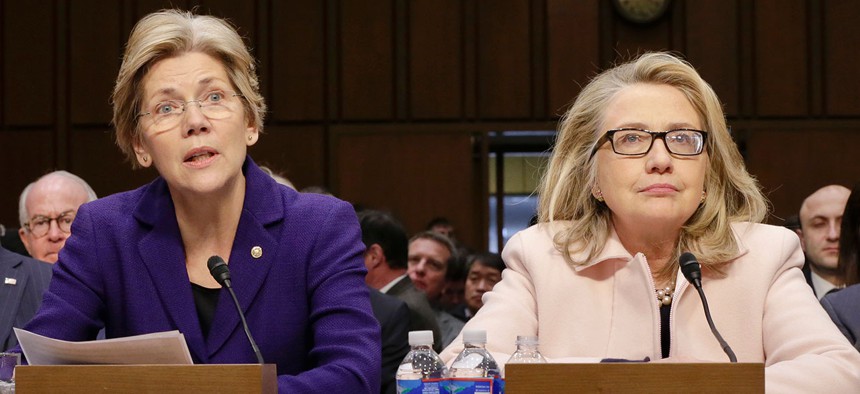
J. Scott Applewhite/AP file photo
Would Clinton Pick a Female Running Mate?
A top aide to the Democratic frontrunner has said there are women on her short list for VP.
What’s more historic than the first major female presidential nominee? The first two-woman presidential ticket, of course.
If it happens. But according to Hillary Clinton campaign chair John Podesta, it’s a distinct possibility. “We’ll start with a broad list and then begin to narrow it. But there is no question that there will be women on that list,” he told The Boston Globe. To be fair, this isn’t the first time Clinton or her aides have mentioned the idea. In January, she told Rachel Maddow she would “absolutely not” rule out a female running mate. Some of the names that are circulating: Senators Elizabeth Warren (of course), Claire McCaskill, Jean Shaheen, and Amy Klobuchar; and Governors Maggie Hassan of New Hampshire (an unlikely choice, as she’s running for U.S. Senate) and Gina Raimondo of Rhode Island.
It’s tough to say just how serious a possibility the two-woman ticket is. After all, Clinton is simply not ruling things out, and there’s a long time to go until she has to make the final choice. But what would she stand to gain by picking a woman as her running mate?
One reason could be that historic angle. In 2008, Clinton didn’t make as much of her role as a woman as she might have. In part, that’s because the “historic candidacy” argument didn’t really cut in her favor in a race against Barack Obama. But Clinton set the tone for her 2016 run when she bowed out of the 2008 race, when she said, “Although we weren't able to shatter that highest, hardest glass ceiling this time, thanks to you, it's got about 18 million cracks in it.” This time around, she’s been more willing to put gender front and center—speaking repeatedly about her roles as a mother and grandmother, for example.
But Clinton’s ability to capitalize on that is somewhat undercut by her own unpopularity. Voters might be interested in the idea of a woman president, but they’re not necessarily excited about the idea of this particular woman president. Adding another woman to the ticket might help encourage the urge to vote for an historic ticket. Emphasizing the woman angle might be especially effective against Donald Trump, should he win the nomination, given his long history of demeaning comments (and allegations of worse) against women.
On the other hand, Trump already polls extremely poorly among women—in a recent Gallup poll, 70 percent had an unfavorable impression of him. Meanwhile, Clinton beats him handily among women in head-to-head general-election polling. (She also beats Ted Cruz by a healthy but slimmer margin.)
The importance of a running mate is a matter of dispute among political scientists and observers. One matter of consensus is that it’s not very much use to choose a vice-presidential candidate in order to win his (or her!) home state. Even nationally, the effect is negligible—in a study of elections from 1968 to 2010, two political scientists found that the running mate had a net effect of at most 1 percent of the total vote, not enough to sway hardly any election. (Sorry, Al Gore.) Vice-presidential candidates seem to often have the most effect when they drag a ticket down. (Sorry, John McCain.)
There was a time when a female vice-presidential candidate seemed revolutionary, to say nothing of a female presidential candidate, but that time was 1984. Eighty percent of Americans say the country is ready for a female president, and that number has climbed steadily in recent years. In summer of 2008, it was closer to two-thirds of the population. As the idea of women as top politicians becomes normalized, the idea that a presidential ticket could be comprised of two women comes to seem less like careful (or, more darkly, cynical) political calculation and more like an obvious move. Forget asking why Hillary Clinton might choose a female running mate. Maybe a better question is this: Why wouldn’t Hillary Clinton consider a female running mate?






